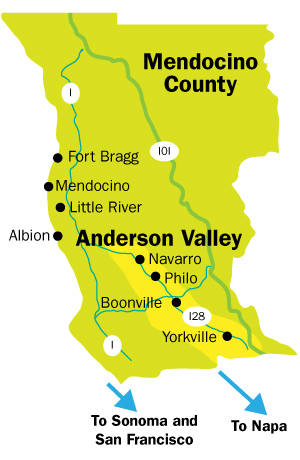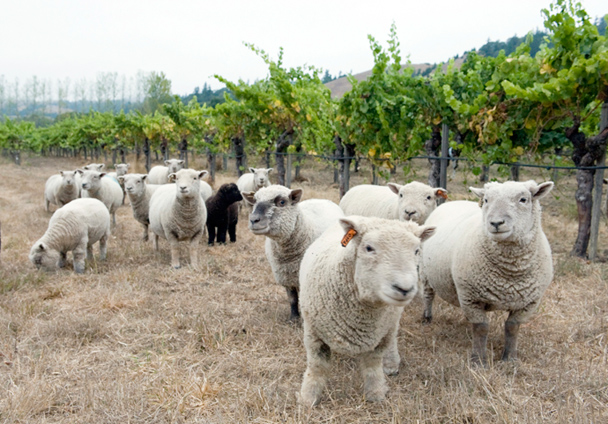Northern California wine country is endlessly satisfying for travelers—has anyone ever come back from Napa or Sonoma having had a bad time? But if you’re craving a new wine region to conquer, head north to the Anderson Valley, a much-lower-profile place that happens to be turning out some of the best wines in California.
Driving north from Sonoma into Mendocino County, home of the Anderson Valley, you can feel the shift into what feels like another state, or another world—one with fewer people, redwoods that are even more enormous, and a general hush. To get a sense of why it’s so serene, look at a map. Route 128, running north-south through the valley for a solitary 30 miles, is crossed only once by a road of any consequence.
Getting in or out of the narrow Anderson Valley requires some harrowing driving, however. To the north, the towering redwoods crowd and darken the curving road; you’ll need your lights even in daytime. To the south, hairpin turns and steep grades completely justify the 15-mile-an-hour speed limit signs.
Not that the locals mind. “We like that the roads are wind-y,” says Alan Thomas, a British-born transplant from New York’s tech sector who works as a farmer, handyman, and occasional waiter (everyone in the valley seems to have two or three jobs). “It keeps us from becoming Napa.”

Boonville’s linguistic trick worked, for a while at least. “People used to drive through town and not stop,” says Johnny Schmitt, proprietor and executive chef of the Boonville Hotel, a 10-room gem decorated in a style one might call tin-roof modern. The excellent prix fixe dinner changes each night and is apt to include mushrooms foraged by the staff and a chicken raised by a friend. The feel of the whole experience is improvisational and warm, and the restaurant also welcomes guests not staying on the premises.
Schmitt’s parents, Don and Sally, founded Napa’s now-legendary French Laundry, eventually selling it to super-chef Thomas Keller. The elder Schmitts then established the Philo Apple Farm, an Anderson Valley lodging complete with a cooking school and farm stand. (Johnny’s sister Karen, along with her husband, Tom, now run the farm.) Just up the road from the Boonville Hotel, the farm has four stand-alone cottages, all in the family style—uncluttered yet cozy.
Less than an hour’s drive from northern Sonoma’s Dry Creek Valley, the Anderson Valley qualifies as a destination in its own right these days, thanks to its stellar wines. They’re a direct result of the climate: the coolest high-quality winegrowing region in California. For the past 30 or so years, wineries headquartered in other parts of the state (and elsewhere in the world) have raised grapes here, or bought from local growers, to make wines from varietals that love the cold—Pinot Noir, Gewürztraminer, and Pinot Gris in particular.
Although Pinot Noir is also grown in Sonoma and many other places, wines made from those grapes that hail from the Anderson Valley have a particular freshness and delicacy. That’s why the great French Champagne house Louis Roederer, maker of the famous Cristal, set down American roots here for its Roederer Estate bubbly. One sip of the Brut Rosé NV (roughly half Pinot and half Chardonnay)—a pale-pink sunset of a wine with many flavor layers of nuts and fruit—and you’ll see why the estate found the region so appealing.
Partly because of a rising taste for cool-climate wines worldwide, more and more wineries have decided to set up shop in the Anderson Valley full-time. “In the last 10 years, this place went from enormous potential to realizing that potential,” says Zach Rasmuson, the winemaker for Goldeneye, a Pinot specialist that is owned by Napa-based Duckhorn Vineyards. Rasmuson’s beguiling Estate Grown Narrows Vineyard Pinot Noir 2009—from the northernmost outpost of this northern valley—has a funky, complex nose, fine sawdust tannins, and a hint of black licorice.
Forward-thinking Anderson Valley pioneers, like Deb Cahn of Navarro Vineyards, are delighted (and vindicated) by the region’s newfound success. Back in 1973, she and her husband, Ted Bennett, had a choice: “We could either get 40 acres in Napa or 910 acres up here,” Cahn explains. They took the road less traveled and now preside over a successful operation specializing in crisp, delicious Alsatian varietals, well represented by their zingy 2009 Gewürztraminer.
Eco-friendly, sustainable, and organic are more than buzzwords around the valley—they’re a true lifestyle. Cahn, for instance, is a rancher and farmer in addition to being a winemaker. She raises sheep to eat and sell, but also for a unique wine-related purpose. “We use the lambs for weeding,” she says, of the short-statured Babydoll breed. “They can get the weeds, but they aren’t tall enough to eat the grapes.” (Check them out on the Lamb Cam on the winery’s Web site.)
The Roederer, Goldeneye, and Navarro wineries—as well as two other must-visits, Breggo Cellars and Foursight Wines—are all within 15 minutes of one another on Route 128. But once you get this far north, it only makes sense to venture onward along the narrow roadways to Mendocino, the well-known burg on the wave-beaten coast. About an hour’s drive north of Boonville, you’ll find the village on one of the most spectacular oceanside stretches of the famed Highway 1.
If views are your thing, consider a stay just south of Mendocino proper at the Albion River Inn, home to 23 simply decorated rooms and cottages on a bluff overlooking the Pacific. It’s easy to ignore the slightly faded furniture because the big show is the crashing surf just outside your window. Just sit a spell and stare. Similar accommodations at the nearby Little River Inn are mostly on the other side of Highway 1, but here you’ll still enjoy fabulous ocean views, as well as country club–style amenities, including golf and tennis.
Mendocino itself is full of Victorian wedding-cake houses—and at times a too-cutesy vibe. But the journey is worth it for a meal at Cafe Beaujolais, located in a tiny yellow clapboard house. Starting in the late ‘70s, former owner Margaret Fox, joined later by Chris Kump, put this spot firmly on the map for food lovers across the country. Today chef/owner David LaMonica turns out local-focused, French-inflected fare, steering clear of preciousness with lunchtime dishes like a hearty short-rib sandwich alongside excellent fries.
The next town up the coast is Fort Bragg, and though it won’t win prizes for its looks, it does offer a heckuva good pizza joint: Piaci Pub & Pizzeria. A local favorite, it’s got a surprisingly good wine-by-the-glass list, the medium-thick crust comes out perfectly crispy, and conversation remains boisterous at the bar, where everyone seems to already know one another, even if they’ve just met.
That kind of bonhomie is typical of Mendocino County, and the wines that are luring people to the area are similarly unpretentious. It’s worth a few twists and turns to get to know both the place and its bottlings better.
Ted Loos, author of the Tasting Notes column on Epicurious.com, also contributes to Vogue, The New York Times, and other publications. He last wrote for Gourmet Live about France’s Loire Valley. Follow him @LoosLips on Twitter, where he tweets the #WinoTheDay.

